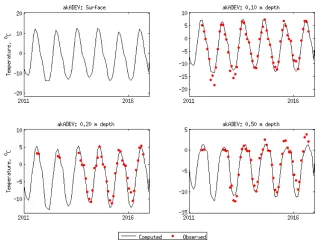Scientists at the University of Alaska Fairbanks completed adaptation of the GIPL permafrost model for activities outlined by Task 1.1B. The GIPL model is currently forced with the historical CRU datasets and a composite average of five GCMs for the future climate projections, downscaled to the 2km resolution. Simulated ground temperatures were compared to observations, prior to the summer of 2017, at 18 sites across the peninsula. The sites were grouped according to the Alaskan Existing Vegetation Type map and allow parameterization of thermal properties for the dominant ecosystem-types, covering about 80% in the Seward Peninsula. Furthermore, using a data assimilation technique (minimizing a misfit between observations and their model counterparts), we reconstructed thermal properties of the ground material and snow cover for each selected ecosystem-types. As a result, thermal properties are available for more than 80% of the study area. For the remaining 20% of the area (e.g. barrens on the high mountain slopes), thermal properties of the ground material are to be taken from the literature. As a result of our activities within this reporting period, we calibrated the GIPL model according to the available data and are now in a good position to start high-resolution modeling across the entire peninsula.
For more information, please contact:
Matvey Debolskiy
mvdebolskiy@alaska.eduDmitry Nicolsky
djnicolsky@alaska.eduSantosh Panda
skpanda@alaska.eduVladimir Romanovsky
veromanovsky@alaska.edu

